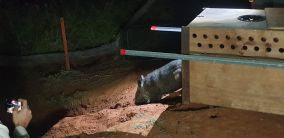Protected Animal Translocation Policy


One of the greatest threats facing our native species is habitat loss and fragmentation, particularly in the face of a changing climate. Protecting and restoring habitat are two key strategies that the Queensland Government applies to ensure populations of Queensland’s native species remain sustainable and viable.
A third strategy, which may be appropriate in certain circumstances, is animal translocation. Where a species is facing serious threats, and cannot be suitably protected without intervention, we may consider undertaking, or approving, a translocation of individuals of a particular species to another location, to give the species a more secure future.
In some cases, protected animals may have already been removed from the wild to be part of a captive breeding program with the goal of eventually reinforcing existing populations or establishing new ones. Several of these initiatives have already been undertaken, resulting in improved recovery outcomes for threatened species both within Queensland and interstate. These translocations have relocated animals to locations both within their current and former distributions. Find out more about current and recent translocation projects on the threatened species featured projects web page.
Protected animal translocations must be guided by science and be adequately justified. They also need to be carried out with appropriate consultation and inclusion, for example, the process should always be informed by the traditional knowledge and cultural connections of First Nations communities. When planned and carried out appropriately, protected animal translocations can help conserve biodiversity while also restoring First Nations Country.


While in some circumstances translocation is a key tool for conservation of a species, it may also be used as a wildlife management tool. For example, in situations where there is authorised land clearing, or where animals are causing a serious safety concern, one of the management options may be to assess the animal’s suitability for translocation. Also, just before or after a natural disaster, it may be appropriate for wild animals to be translocated to locations where they are kept in captivity until such a time that they can be safely returned or relocated.
The Department of Environment, Science and Innovation has developed the Protected Animal Translocation Policy which sets out the key principles for deciding when translocation may be suitable. The policy includes a list of detailed considerations the department follows to ensure the best possible decisions are made. This aims to maximise the chances of translocation success, minimise the risk of any adverse conservation or welfare impacts, ensure that all relevant parties and stakeholders are appropriately included in the process, and maximise knowledge transfer from each translocation project. Further resources about translocation will be released in the near future to support the implementation of this new policy.
All translocations of native animals require authorisation under the Nature Conservation Act 1992. The specific type of authorisation required will depend on the particular circumstances. If you believe an animal translocation may be appropriate, please contact the department by email at wildlife.management@des.qld.gov.au and provide the following initial information:
- species name (common and scientific)
- numbers of individuals proposed to be translocated
- where animals are proposed to be taken from and released to
- proposed timeframe (proposed commencement and completion dates)
- justification for the proposed translocation
- the type of translocation (see the Protected Animal Translocation Policy for further information).


